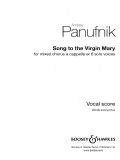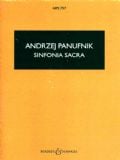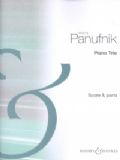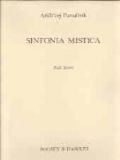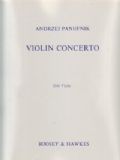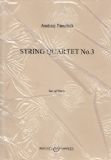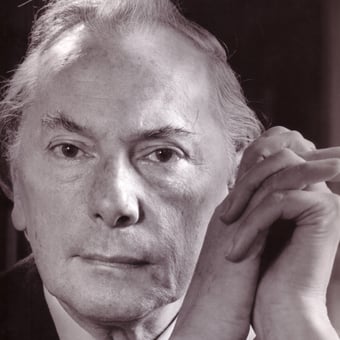
Andrzej Panufnik
An introduction to Panufnik’s music
by Calum MacDonald
One of Andrzej Panufnik’s earliest surviving works, the Tragic Overture (destroyed during the Warsaw Uprising, but reconstructed from memory soon afterwards) illustrates, in an extreme form, the central paradox of this composer’s distinctive art. The entire work is generated from a single tight 4-note chromatic cell, ceaselessly permuted, inverted, augmented, and articulated by a remarkable rhythmic drive to produce an indivisible and remorseless musical argument. The formal patterning is intricate to the point of abstraction; yet the emotional impact of this truly ‘tragic’ score is immense, and could hardly have been achieved without the obsessive concentration of its musical raw material.
Over five succeeding decades, Panufnik developed and refined a wholly original approach to composition. A germinal cell of three or four notes gives rise to each piece’s unique harmonic and melodic content. Projected into the sphere of form along with metre, tempo, timbre and dynamics, it also gives rise to its overall structure. Often these structures – some of which additionally make play with number symbolism – lend themselves to expression in diagram form; the interlocking symmetries of Autumn Music and Universal Prayer, the tantric interpenetrations of Triangles, the clockface circle of fifths of the Miniature Studies, the ascending spheres of Sinfonia di Sfere, the efflorescent ‘cosmic tree’ of Arbor Cosmica. The approach may resemble (and to a limited extent is) a form of serialism; but its spiritual orientation, and its reinterpretation of traditional harmonic function, are vastly different from the Schoenbergian 12-note method. They suggest, rather, parallels with Renaissance philosophical doctrines of microcosm and macrocosm. Panufnik’s diagrams evoke the ‘mystical geometry’ practised by certain 16th-century Hermetic magicians, some of whom flourished at Kraków in his native Poland: talismanic symbols not of mathematics but mathesis, a deeply religious ‘higher science’ of the soul that used the forms of geometry to express human truths.
Panufnik’s music is intensely human and direct in its emotional effect. Sometimes the elaborate patterning intensifies that effect. Sometimes it performs a very necessary function of objectification and balance: tumultuous feeling is disciplined into sculptural forms or evocations of hieratic ritual. Sometimes the works become subjects for contemplation rather than immediate involvement. The feelings themselves arose from sources both religious and personal – sometimes autobiographical, as in the childhood memory of thrumming telephone wires, and the secret messages encoded in their ‘music’, that inspired the Second String Quartet.
These concerns united in Panufnik’s lifelong identification with his native country: its musical culture (Old Polish Suite, Hommage à Chopin), its folk traditions (Third Quartet) with their melodies and dances (Sinfonia Rustica), its landscapes, its religious history (Sinfonia Sacra, Song to the Virgin Mary), its agonies in war (Tragic Overture, Sinfonia Elegiaca) and its political turmoil since (Nocturne, Katyn Epitaph, Sinfonia Votiva and Bassoon Concerto).
By no paradox at all, this identification with what was precious in one country led naturally towards a consciously international outlook. Some works seek to address the shared existential predicament of humanity in general – Universal Prayer, A Procession for Peace, and the Ninth Symphony, Sinfonia della Speranza. The vast self-reflecting palindrome of this latter work is the monumental climax of Panufnik’s concern with ordered symmetry as a symbol of his humane idealism. Afterwards, his last music started to move in new directions. The unexpected harmonic toughness of the chamber orchestra piece on which, with no incongruity, he bestowed the title Harmony and the rhapsodic bravura of the Tenth Symphony signalled a new formal freedom and boldness of expression in his late seventies, and they will perhaps come to be seen as among the most original of his achievements.
Calum MacDonald, 1994
Bestselling Titles by Andrzej Panufnik
-
Publisher: Boosey & HawkesIn Stock: Usually despatched within 24-48 hours$12.69
-
Publisher: Boosey & HawkesIn Stock: Usually despatched within 24-48 hours$45.72
-
Publisher: Boosey & HawkesUsually despatched within 7-10 working days - Lead times may vary in the case of supplier shortages or delays$27.31
-
Publisher: Boosey & HawkesUsually despatched within 7-10 working days - Lead times may vary in the case of supplier shortages or delays$64.76
-
Publisher: Boosey & HawkesUsually despatched within 7-10 working days - Lead times may vary in the case of supplier shortages or delays$15.23
-
Publisher: Boosey & HawkesUsually despatched within 7-10 working days - Lead times may vary in the case of supplier shortages or delays$29.85



